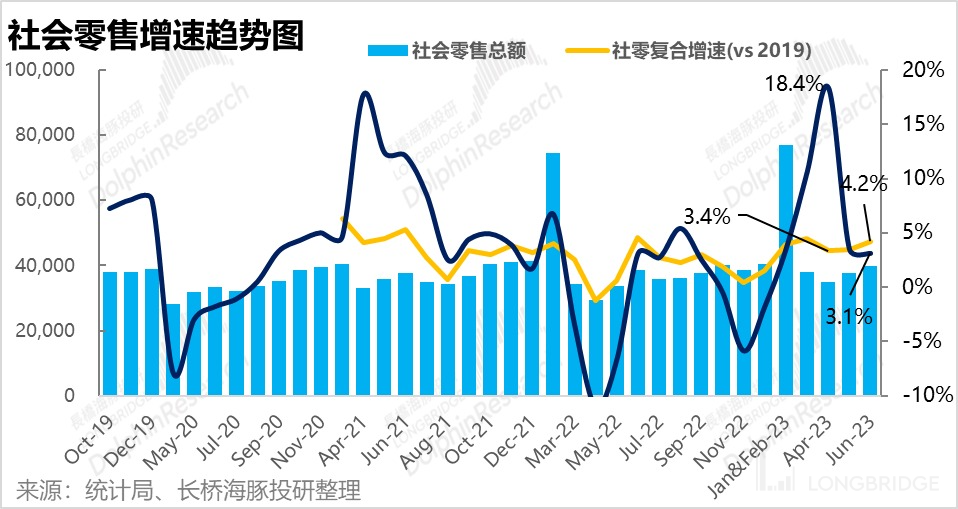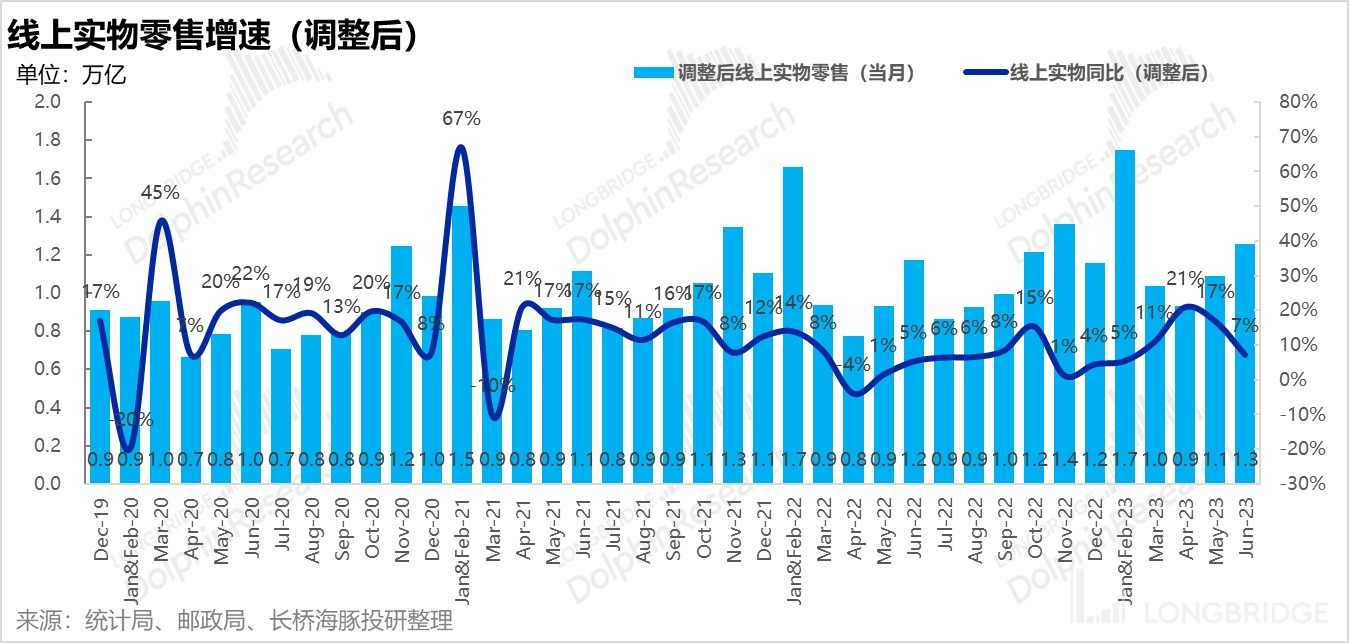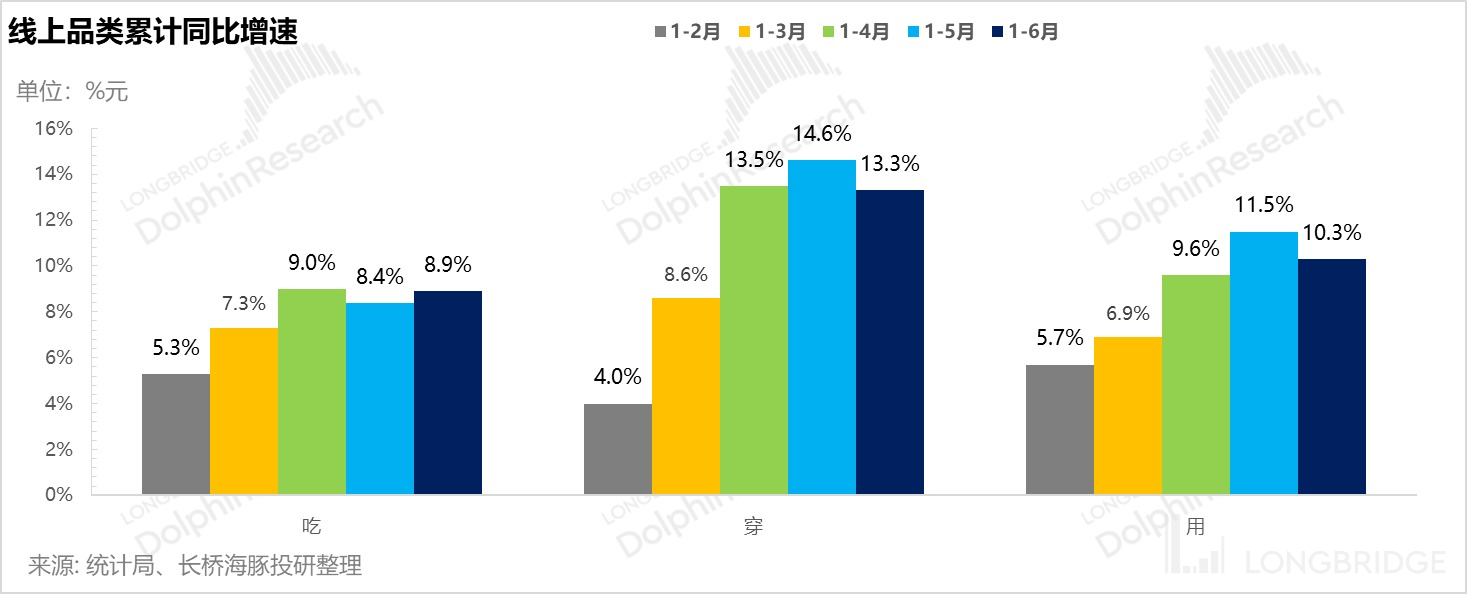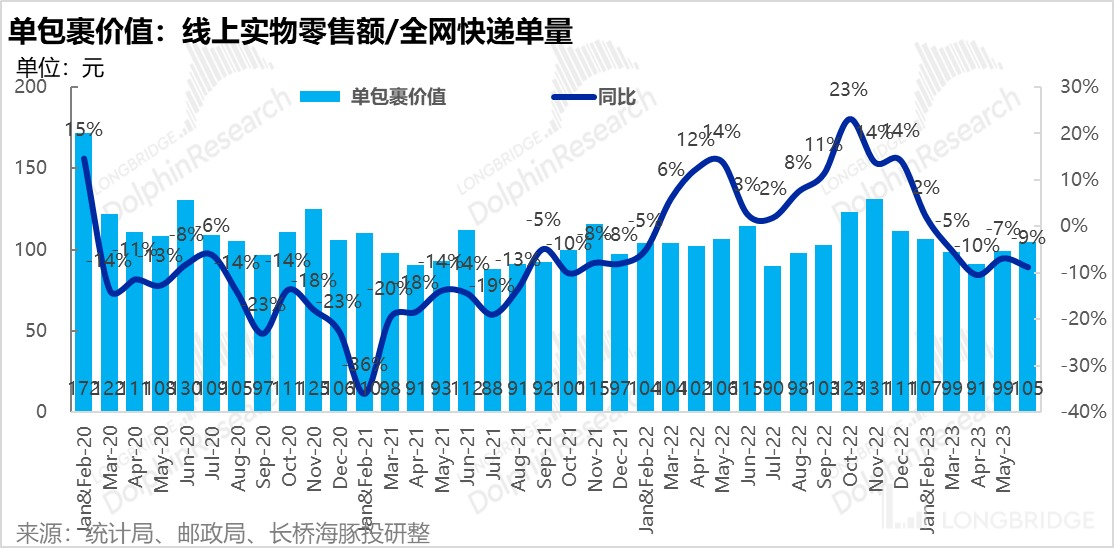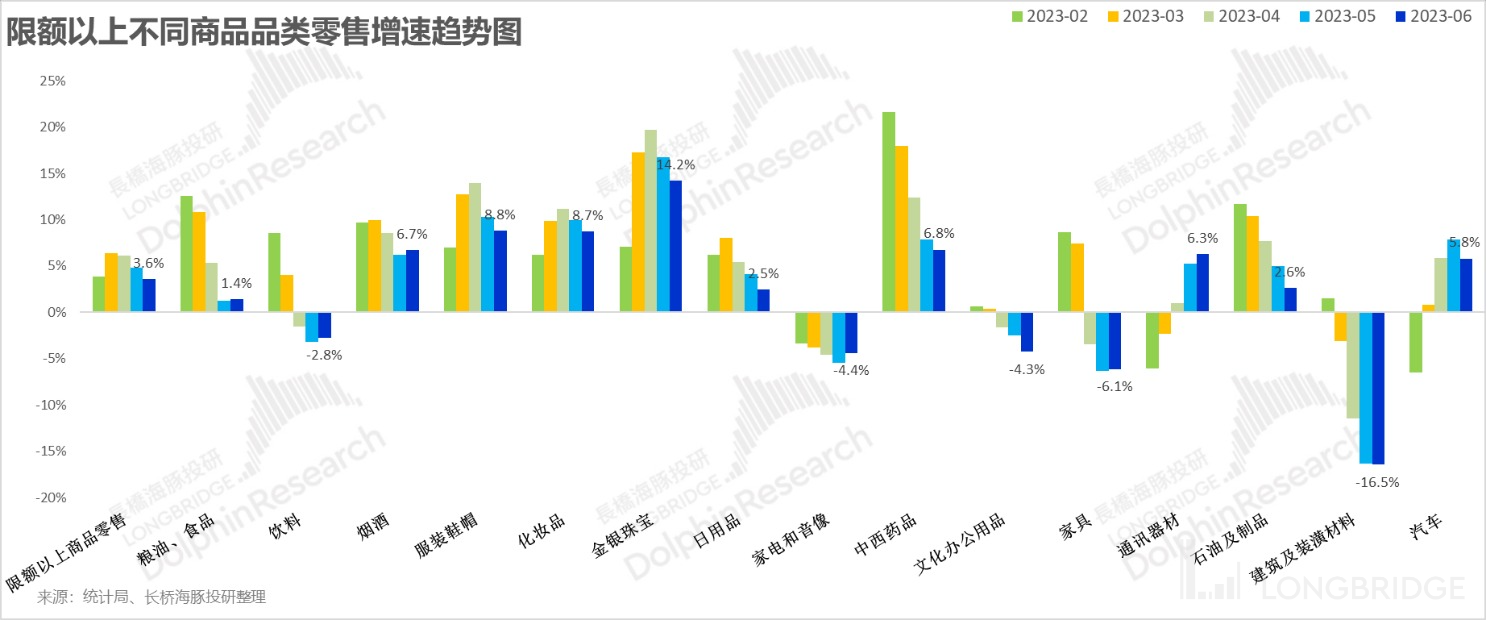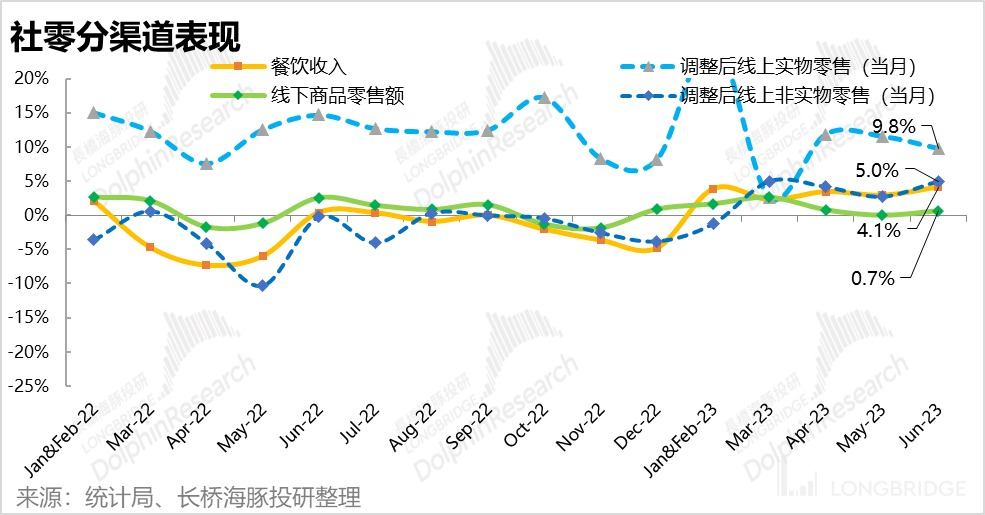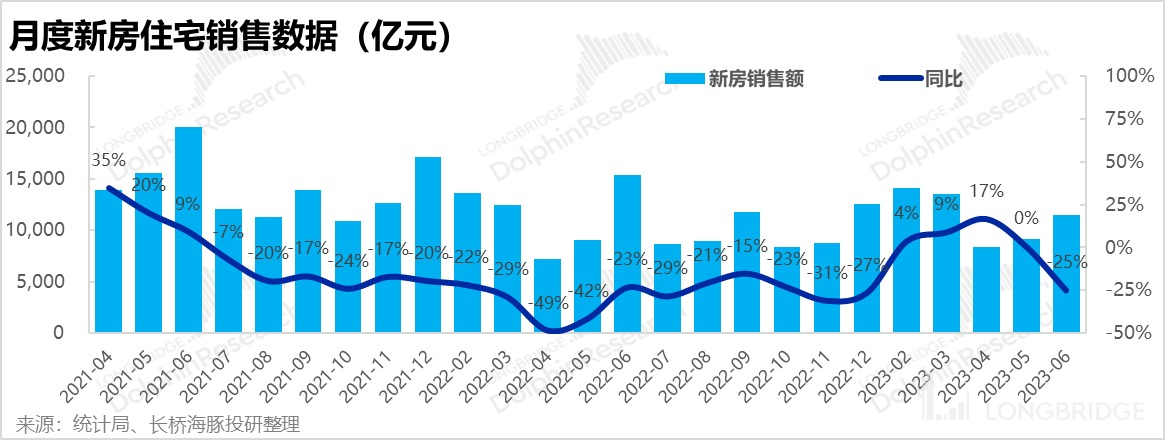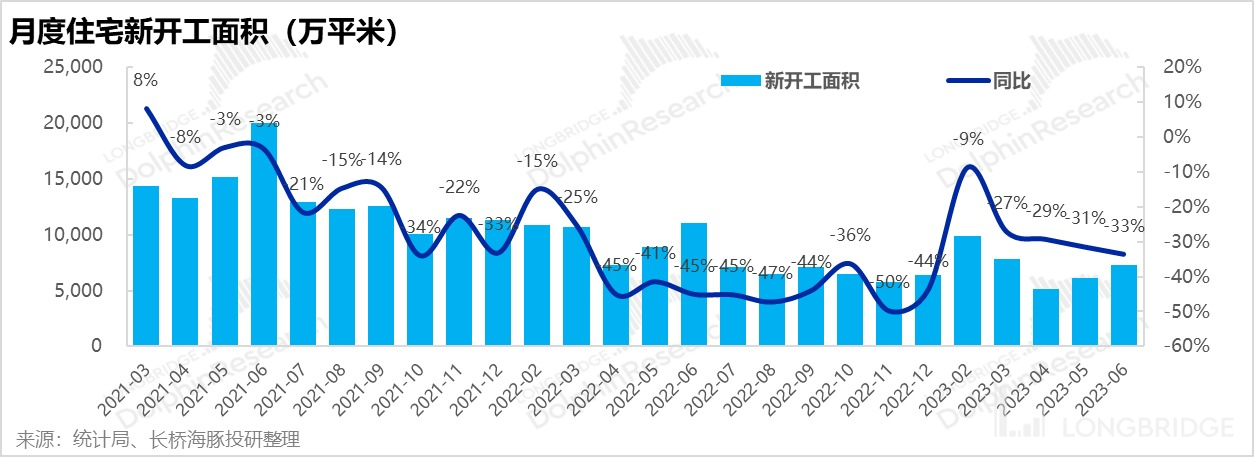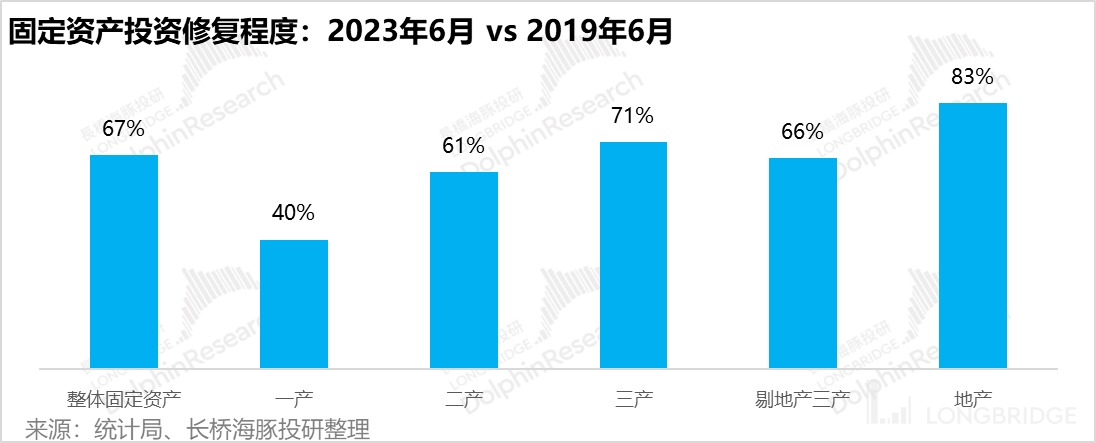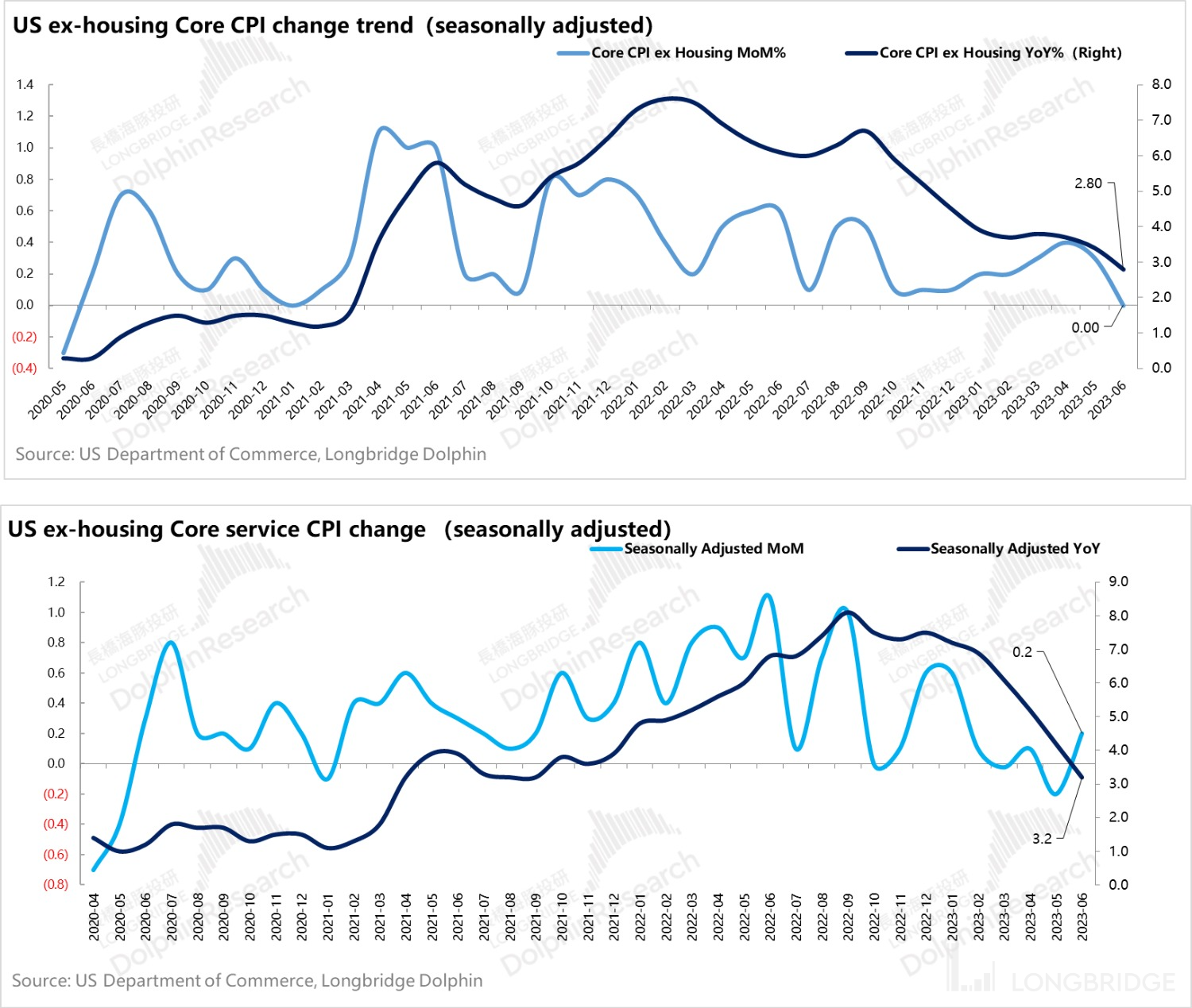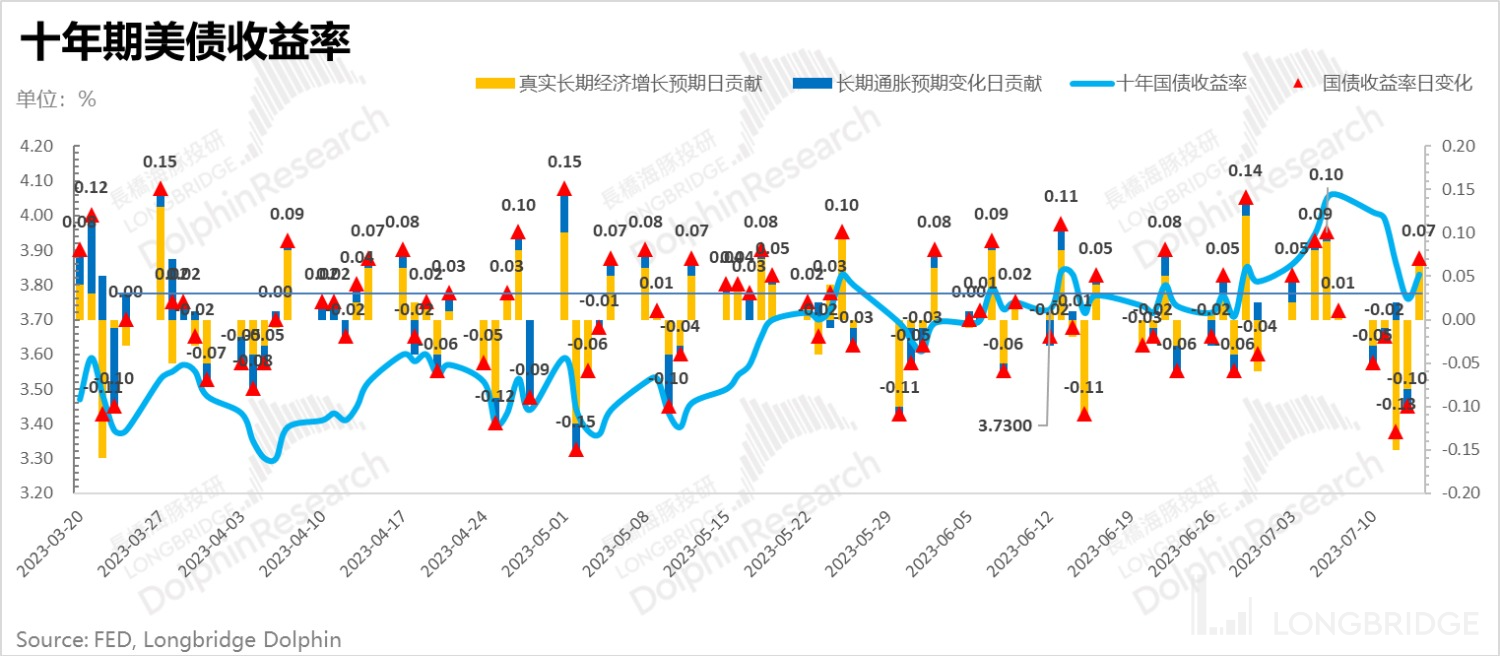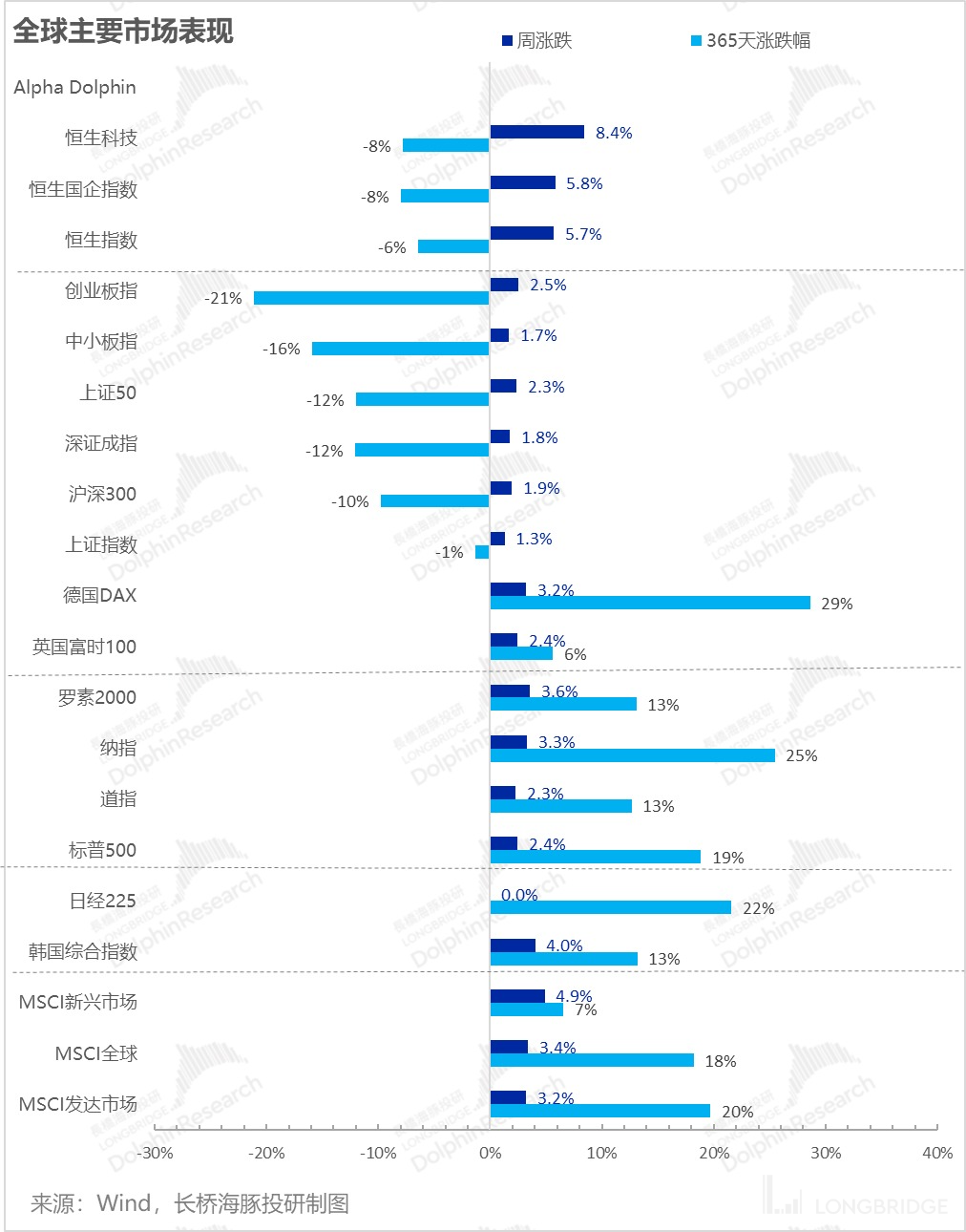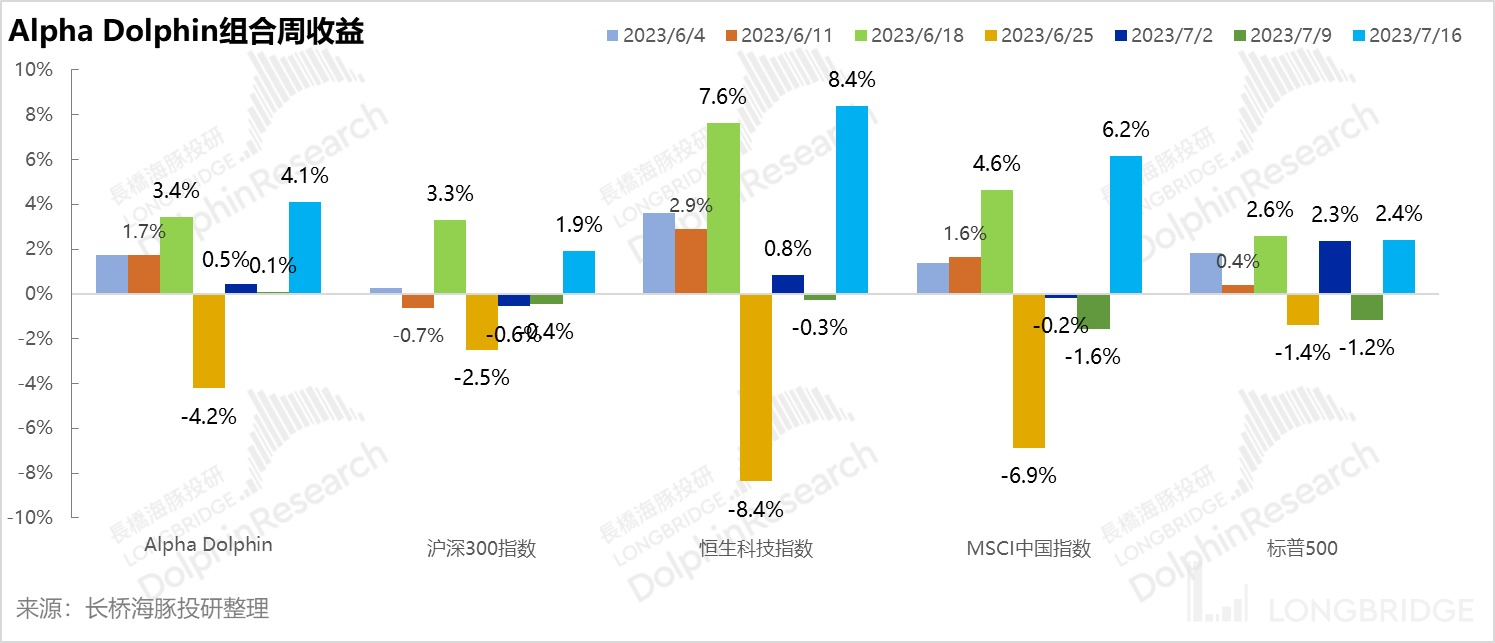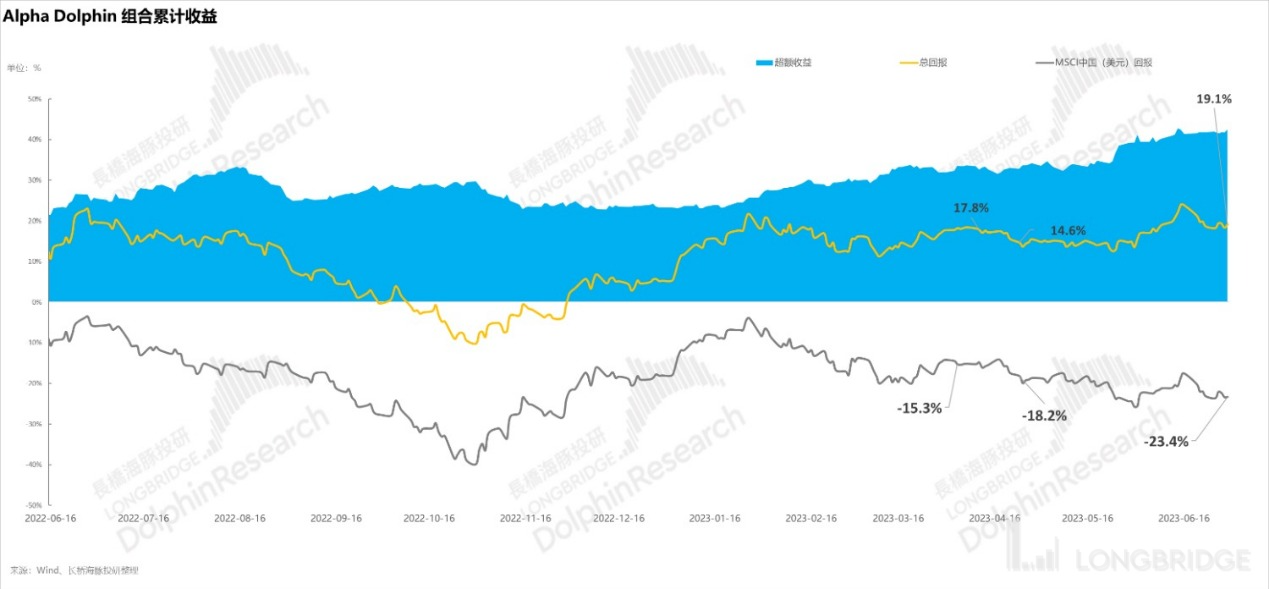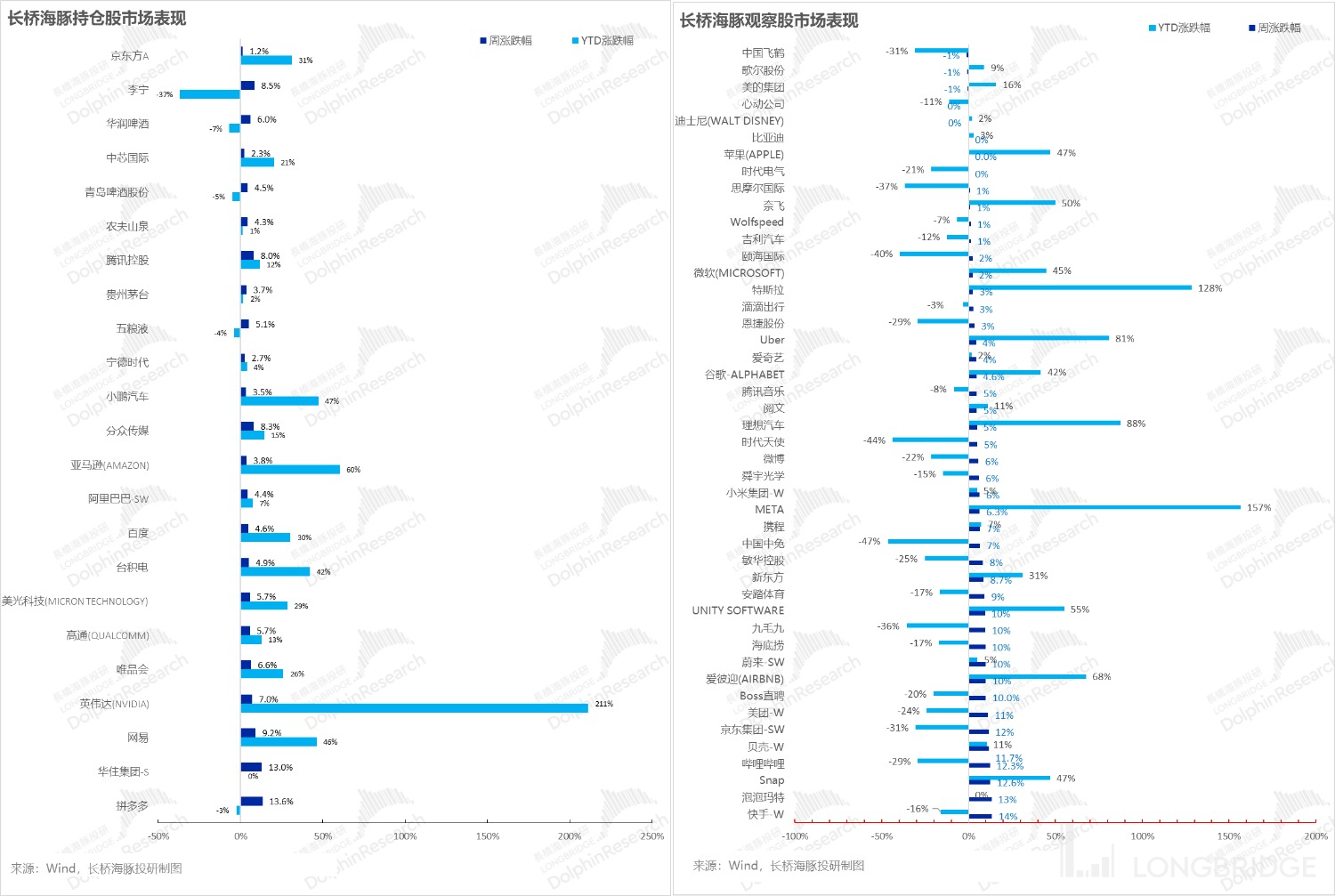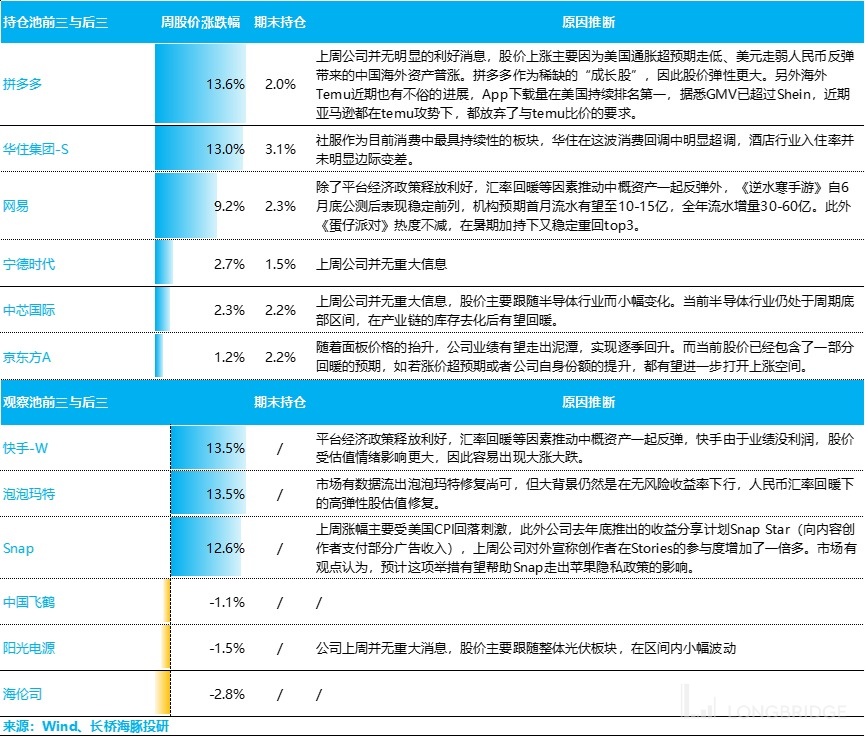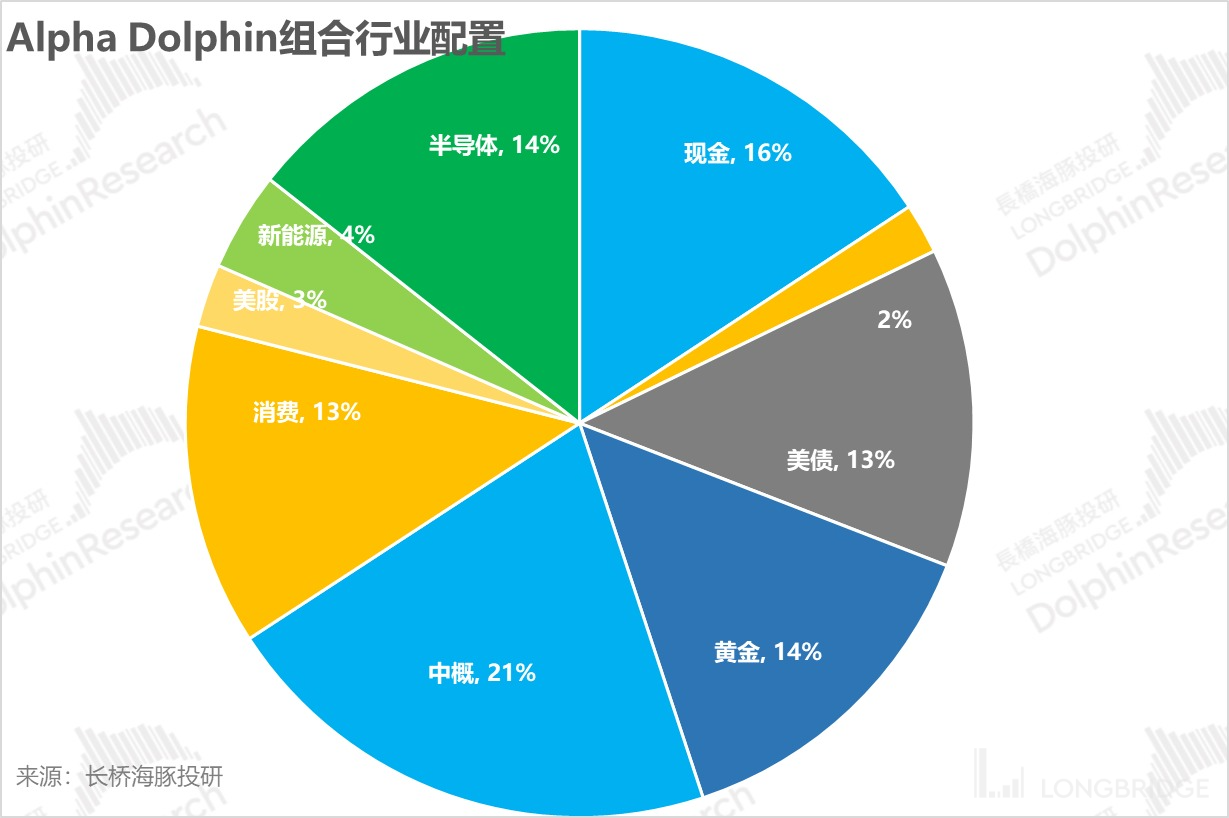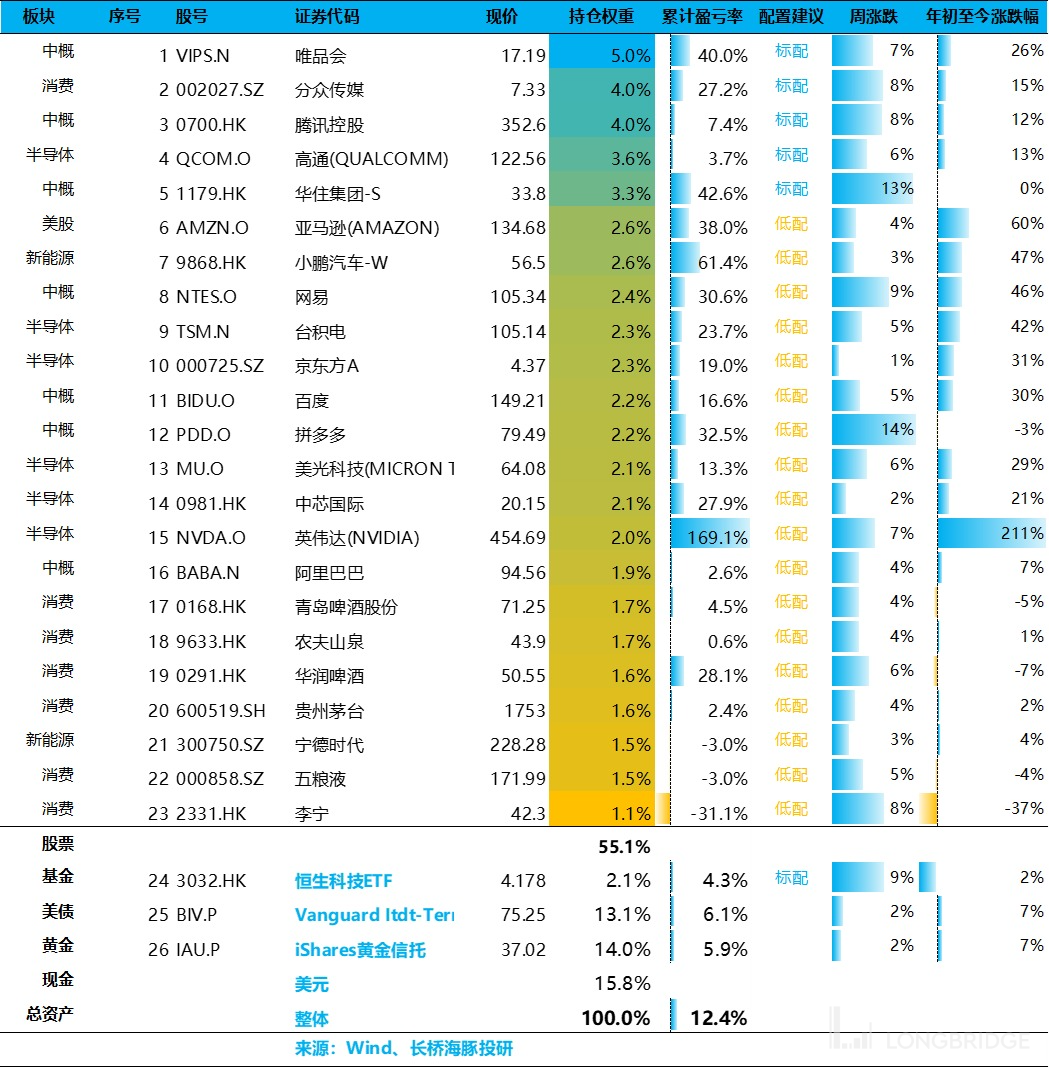"Reality" Strikes, How Far Can the Rebound of Chinese Concept Stocks Go?
Hello everyone, here is the summary of this week's core information on the combination strategy by Dolphin:
- Weak domestic demand: Two main lines of consumption: a) Consumption related to going out for enjoyment is recovering: the demand for service consumption is still being repaired, whether it is dining out (Meituan) or travel services (Ctrip, etc.); however, the restorative momentum for fashion, beauty, and jewelry has clearly slowed down.
b) Overall poor performance of goods, but the worst is offline goods consumption + post-cycle consumption in the real estate sector. After being stagnant for four years with zero growth, there was a short-lived excitement after the restrictions were lifted, but hope is still not in sight.
The biggest marginal change in social retail sales in June is that although major platforms fiercely competed on prices during the 618 shopping festival, the year-on-year growth of online consumption has also slowed down compared to the high base of last year.
-
Throughout the real estate chain, except for completed projects, everything else is declining, with a decline of around 20% in general, including real estate investment. In terms of overall fixed asset investment, real estate investment has performed relatively well compared to the same period in 2019, and the shrinkage of domestic demand in enterprises excluding real estate is more significant than that of end-consumer consumption.
-
As of June, the cooling of prices confirms that the US economy is in a perfect transition phase from prosperity to weakness: employment and excess savings are still present, and the excess inflation caused by supply-side disruptions (oil + food) is clearly dissipating. At the same time, in terms of core inflation, consumer goods consumption represented by second-hand cars is clearly cooling down, with only labor inflation stubbornly rising.
-
Valuation of Chinese concept assets: The numerator looks at the fundamentals, including macroeconomics, industry competition, and individual stock performance; the denominator looks at the pricing of risk-free assets in the US stock market, such as ten-year treasury bonds. Currently, the denominator is trending downward, and the numerator is at its worst moment in terms of macroeconomics. Although industry competition is still relatively intense, individual stocks generally reduce costs and increase efficiency. Among consumer stocks, Chinese concept stocks are relatively cheaper and their valuations can be restored. However, domestic demand will also suppress upward potential, leading to higher volatility this year, with opportunities for selling high and buying low.
Here are the details:
As we reach the middle of the month, there have been frequent heavyweight macroeconomic data releases from both China and the US. Let's start with the domestic part:
1. Domestic demand: Did social retail sales in June only hold up in terms of "eating, drinking, and entertainment"?
Today, the National Bureau of Statistics released the social retail sales data for June this year. As a major indicator of domestic demand, the year-on-year growth rate in June, which is the first month after the normalization of the base, can better reflect the normalized consumption growth level after the abnormal base.
Overall impression: Although there are slight signs of marginal recovery, weak consumer demand remains a fact.
1) Weak performance in June: Nominal social retail sales reached nearly 4 trillion yuan, with a year-on-year growth rate of 3.1%. In June last year, which was the first complete month after the lifting of restrictions, the year-on-year growth rate was 3.1%, significantly lower than the annual GDP growth target of 5%. The weakness in consumption is evident.
The four-year compound growth rate based on 2019 as the base is 4.2%, which is slightly better compared to May's 3.5%, but still significantly lower than the four-year compound growth rate of 4.5% in March, when people returned after the Spring Festival.
2) Offline goods have experienced negative growth
a. Slowdown in offline physical goods under a high base: While online physical goods performed relatively well in May, the growth rate of online consumption in June has returned to mediocrity. According to Dolphin's rough estimate, the online retail sales of physical goods in June reached 1.26 trillion yuan, a year-on-year increase of 7%. Compared to the compound growth rate of 9.8% over the past four years, based on 2019 as the base year, the growth rate in June has significantly declined from the levels of 12% and 11.6% in April and May.
In terms of specific categories, although the growth rate of clothing and daily necessities has shown some recovery compared to the previous year, the pace of recovery has noticeably slowed down. This implies that the restorative momentum for clothing and daily necessities in June has weakened, and currently, only essential food consumption remains resilient.
Furthermore, looking at the average package value of online physical goods, it is evident that price deflation in online consumption is still significant. Cost-effectiveness remains the dominant theme this year.
Looking at the retail data of quota-based enterprises (including offline), durable goods consumption in the downstream real estate chain, such as household appliances, audiovisual equipment, furniture, and building materials, continues to be bleak. Except for a slight narrowing of the decline in household appliances, the decline in building materials and furniture remains significant.
As for the beauty category, including clothing, shoes, hats, gold and silver jewelry, and cosmetics, the year-on-year recovery is still ongoing but at a noticeably slower pace. Clothing, as a major consumer category, has returned to a growth rate of less than 9%. The only resilient category this month is tobacco and alcohol.
In addition, communication equipment, mainly smartphones, has shown signs of continuous improvement. The year-on-year growth rate has reversed from a negative growth of -6% at the beginning of the year to a positive growth rate of +6%. It is worth paying attention to whether companies like Xiaomi can improve their performance in the second quarter.
b. Offline is already experiencing negative growth
For offline physical goods, the year 2023, after the lifting of restrictions, has not become their redemption. Instead, under the extremely cost-effective online strategies, offline market share has been further eroded.
Among the three suffering brothers—non-physical online goods, offline dining, and offline goods—only offline goods have truly experienced a bleak situation. In June, the year-on-year growth rate was a negative 0.8%, with a compound growth rate of 0.7% over the past four years. The recovery is very weak. C. Slowdown in Dining Out and Outbound Travel
Meanwhile, online non-physical retail in June continued to recover rapidly. As this segment is mainly focused on activities such as dining and travel tickets, the ongoing recovery indicates that the demand for leisure activities is still being unleashed.
The year-on-year growth rate of dining revenue is also decent, with a further acceleration to 4.1% on a compounded basis over the past four years.

Overall, in terms of the recovery of consumption related to going out and enjoying oneself: the demand for service-oriented consumption is still present, whether it's dining out (Meituan) or travel services (Ctrip, etc.); however, the recovery momentum for fashion, cosmetics, and jewelry has clearly slowed down.
The situation for physical goods is grim, but the most challenging is offline goods consumption + post-cycle consumption in the real estate sector. After four years of stagnant growth, the opening up of these two categories has brought only temporary joy, and hope is still nowhere to be seen.
The most significant marginal change in June's retail sales is that despite the fierce price competition among major platforms during the 618 shopping festival, the year-on-year growth of online consumption has also slowed down due to the high base effect from last year.
Second, is corporate demand weaker than household demand?
Firstly, in terms of sales data, after passing the low base period in the first half of the year, the amount of new home sales in June decreased by 25% year-on-year, and the transaction area decreased by 27.9%, with a more significant decline compared to May. This aligns with the "bleak" situation reflected in previous high-frequency data.

As for the new construction data, which serves as a leading indicator of future sales volume, it looks even worse. The year-on-year decline in June reached one-third, and the decline has been expanding since the beginning of 2023, indicating a continuous destocking trend.

Among the sub-items related to real estate, only the completion area related to pre-sales and delivery has achieved a positive growth of 16%. However, whether it is the continuous decline in new construction or the 33% drop in the total transaction value of land in 100 cities, it indicates that the real estate sector is still in the process of destocking, and there is currently no sign of a turnaround.
The decline in land market transactions and the poor performance of new construction have led to a 10% decline in fixed investment in real estate in June, which continues to be a significant drag.
Taking a closer look at fixed asset investment, if we compare the recovery level in June this year with the base period of June 2019, real estate investment has performed relatively well during this special cycle. However, the recovery level of fixed asset investment in the primary, secondary, and tertiary industries, excluding real estate investment, is only around 65% of the level in the same period in 2019.
From this perspective, the performance of corporate investment is actually worse than that of household consumption.

3. United States: A Perfect Transition Period?
The economic data released in the United States last week reflected that after a year of inflation, the U.S. economy is in a perfect transition period from prosperity to weakness: employment and excess savings are still present among households, and the excessive inflation caused by supply-side disruptions (oil + food) has clearly subsided. As for core inflation, consumer goods consumption represented by used cars has clearly cooled down, leaving only the persistent rise in labor inflation.
-
The seasonally adjusted CPI and core CPI for June have both fallen back to a MoM growth rate of 0.2%. Since the lagging effect of housing cannot truly reflect the downward trend in real housing costs, the Dolphin pays particular attention to the core CPI excluding housing, which has actually shown zero growth on a MoM basis.
-
As the commodity sector, from upstream manufacturing to downstream retail and consumer goods consumption, is clearly progressing towards deflation, the key now is to observe the service inflation after excluding housing, which is largely influenced by labor costs. This figure has been fluctuating but vaguely shows a downward trend: the MoM core service inflation excluding housing for June was 0.2%, indicating that inflation is no longer stubborn.

A detailed look at the subcategories reveals that a) in the core service categories excluding housing, although there is a persistent shortage of medical personnel, medical inflation is hardly visible, mainly due to significant deflation in medical insurance; b) in transportation services, airfare has continued to decline on a MoM basis, resulting in no inflation in transportation services.
However, this does not mean that labor cost inflation has disappeared. In the subcategories of services that the Dolphin focuses on, which are mainly composed of labor costs, such as sewage and garbage cleaning services in residential areas, home maintenance services (including housekeeping, lawn cleaning, moving, property maintenance, etc.), and other personal services (tax filing, funerals, laundry, haircuts, etc.), the MoM price increases are generally between 0.2% and 0.8%, with an average ranging from 0.35% to 0.4%, which is not significantly different from the current wage increase rate.
It's just that these service categories, where labor is the main input factor, account for a relatively small proportion. For most service categories, labor costs are only one of the input factors. For example, in transportation services, in addition to labor, fuel prices and transportation vehicle prices are also components of service prices.
In the era of technological deflation, the contribution of labor as a production and cost input factor to inflation is perhaps a question worth pondering.
In this wave of inflation, the industry that is truly facing a labor shortage - healthcare (the early retirement of the baby boomers has led to an overall labor shortage and increased demand for medical care) - does not seem to be entirely market-driven. After the government's involvement in providing services, there is a shortage of demand, but prices have remained stable overall. And with multiple factors intertwining and resonating, the common result is that by the end of the first half of 2023, the US economy seems to be in a high-interest, unaffected state, with inflation already dissipating and the economy still intact, creating a dream combination.
Due to this kind of price performance, it seems that the task of combating inflation has already been mostly completed. The previously high 10-year Treasury yield has fallen to 3.8%, and the US dollar has fallen below 100, leading to a global asset frenzy. In terms of asset nature, the more sensitive the asset is to risk-free interest rates, the greater the upward rebound.


IV. Portfolio Returns
On July 14th, Alpha Dolphin's virtual portfolio rose by 4.1%, outperforming the S&P 500 Index (+2.4%) and the CSI 300 Index (+1.9%), but lagging behind the MSCI China Index (+6.2%) and the Hang Seng Tech Index (+8.4%).

Since the start of the portfolio testing until last weekend, the absolute return of the portfolio was 24%, with an excess return compared to the MSCI China of 44%. From the perspective of asset net value, the initial virtual assets of Dolphin were $100 million, and it is currently $126 million.

V. Contribution of Individual Stocks' Profits and Losses
With global assets rising last week amid unexpectedly falling US prices and high risk-free interest rates, Dolphin has been sharing some thoughts on macro, industry, and individual stocks on a daily basis.
As for the rise of Chinese concept stocks, Dolphin has already explained it and will not elaborate further here. At the same time, it emphasizes that currently, in the overall weak consumption situation, most Chinese concept stocks are general consumer assets that have lost growth imagination and technological dividends. The overall opportunity is still a rebound opportunity under undervaluation, and it is difficult to sustain an upward trend. It is necessary to pay attention to short-term opportunities.

The specific companies that have risen or fallen are summarized by Dolphin as follows:
 VI. Distribution of Combined Assets
VI. Distribution of Combined Assets
There were no adjustments made to the portfolio this week. The allocation consists of 24 stocks or ETFs, with 5 of them being rated as standard and 18 rated as below standard. The remaining assets include gold, US bonds, and US dollars.
As of last weekend, the asset allocation and equity asset weighting of Alpha Dolphin are as follows:


VII. Key Events of the Week
Starting this week, some of the US stocks covered by Dolphin will release their financial reports. The first batch includes popular stocks that have recently experienced a rise, such as Netflix, Tesla, and TSMC. The key points of focus for Dolphin regarding these financial reports are as follows:

Risk Disclosure and Statement for this Article: Dolphin Disclaimer and General Disclosures
For recent weekly reports from Dolphin's investment research team, please refer to:
"Looking Ahead: Will US Rate Hikes Amplify Stagflation?"
"Decoding the Mystery of Low US Savings: Is It Sustainable?"
"US Housing Market: Subprime Sins, Why the Resilience?"
"Unraveling the Threads: Where Did the Recession Go, Can It Return?" 《Is the small essay market biased? Extreme pessimism followed by overcorrection is the core》
《Purgatory vs. Celebration, what are the US and Hong Kong stock markets really trading?》
《US stocks pull up valuations, Hong Kong stocks kill beta? Don't despair, a reversal is imminent》
《 Deposit high interest rates in another bank? The probability of a soft landing has increased instead》
《 ChatGPT vs. Performance Release, can giants support the US stock market?》
《 Is the plan of "US recession, China recovery" going down the drain?》
《 The direction of US recession is set, only a minor decline is pleasing, a major decline is harmful》
《 US service consumption collapses, US stocks celebrate?》 《Fed Rate Cut: Just One Moment Away from a US Version of Yu'ebao Ambush?》
《US Stocks Recession, Rate Cut? Trading Has Already Run Ahead Anyway》
《 Silicon Valley Bank Run Crisis: Is the US Recession Running to the Scene?》
《 US Stocks Give Back Gains, Global Markets Can Finally Breathe》
《Inflation Rising: Confirmation? Adversity Brings Opportunity》
《 Putting Inflation Aside, Signals in Alibaba and Baidu Are More Important》
《 Weakness in Hong Kong and the US, Is the Wolf Coming Again?》
《Macro Puppeteer, US Stocks Are a Puppet Market》
《 A Single Candlestick Changes Faith, Tesla Leads the US Stock Market Comeback?》
《 How Far is the "Danger" in the US Stock Market》 《No Chinese New Year Red in US Stocks, but Performance Hammer is Close at Hand?》
《Peeling Back the Roots of Stagnant US Stocks》
《CPI Has Fallen, Why is the Fed Still So Stubborn?》
《Is Service Inflation Really That Easy to Eliminate? Beware of Market Overcorrection》
《The Darkest Hour Before Dawn: Is the Key in the Darkness or the Dawn?》
《US Stocks "Bounced Back" to Reality, How Long Can Emerging Markets Keep Bouncing?》
《Global Valuation Recovery? There's Still the Test of Performance》
《China's Asset Violence Boosts Prices, Why is There a Stark Contrast Between China and the US?》
《Amazon, Google, Microsoft: Falling Stars? The "Meteor Shower" in US Stocks Continues》
《Behind the Expectation of Policy Shift: Is the "Strong Dollar" GDP Growth Unreliable?》 《The Moment of Testing "Steadfastness": Southbound Acquisition vs Northbound Frenzy》
《Slowing Down Rate Hikes? The Dream Shattered Again》
《 Getting to Know the "Iron-blooded" Federal Reserve Again》
《 A Tragic Second Quarter: "Hawkish" Voices, Collective Difficulty in Crossing》
《Falling to Doubt Life, Is There Still Hope for Reversal?》
《 The Federal Reserve Violently Hammers Inflation, Domestic Consumption Opportunities Arise?》
《 Global Markets Plunge Again, Labor Shortage in the United States is the Root Cause
《The Federal Reserve Becomes the Number One Bear, Global Markets Collapse》
《United States Turns Left, China Turns Right, Cost-effectiveness of US Assets Returns》
《Layoffs Too Slow, Insufficient Acquisition, United States Must Continue to "Decline"》 《US Stocks: Celebrating Funerals - Recession is Good, Strong Rate Hikes are Negative》
《Entering the Second Half of Rate Hikes, Opening of "Earnings Thunder"》
《Epidemic Strikes Back, US Faces Recession, Funds Change Their Minds》
《Current Chinese Assets: "No News is Good News" for US Stocks》
《Is Growth Already a Carnival? Does it Mean the US is Definitely in Recession?》
《The United States in 2023: Recession or Stagnation?》
《US Oil Inflation, Can China's New Energy Vehicles Grow Stronger?》
《Faster Rate Hikes by the Fed, Opportunities for Chinese Assets Emerge》
《US Stock Inflation Goes Off the Charts, How Far Can the Rebound Go?》
《Starting from the Ground Up, Dolphin Investment Portfolio is Launched》




